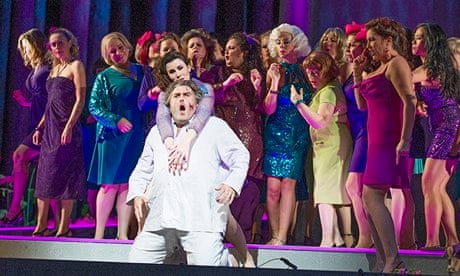The Royal Opera has waited until almost the end of the Wagner bicentenary year to make its contribution to the celebrations, but in every respect it has been well worth the wait. Musically this is a very fine account of Parsifal indeed, while Stephen Langridge's new production confronts this troubled and troubling piece unflinchingly, even if inevitably it raises almost as many questions about the work as it answers.
The more or less 21st-century world that Langridge and designer Alison Chitty invent for the sacred drama is one freed of as many explicitly Christian trappings as possible. Langridge's synopsis in the programme does talk about the "Grail community", but that's all, and while there is little he can do about the references in the text, visually there is nothing specific. The Buddhist element in Wagner's concept is played down just as much, but the community, led by Gerald Finley's bed-ridden Amfortas, into which Simon O'Neill's Parsifal blunders is still clearly bound together by shared beliefs connected with whatever their "grail" is, a bond manifested in the gruesome blood ritual enacted at the end of the first act. Clearly it's a society at war, too, sending a group of armed paramilitaries off into action at the end of that act, and apparently critically weakened by their efforts when Parsifal returns in the third.
Despite some puzzling anomalies – why do so many of the "grail knights" wear spectacles? – it's certainly a dramatically consistent world, dominated by the intensive-care cubicle in which Amfortas is contained, and hardly altering even for the deliberately unexotic realm – flower maidens in headscarves – that Willard White's Klingsor rules in the second. And instead of ignoring or sidestepping the more unsavoury aspects of the libretto, Langridge does attempt to tackle many of them, sometimes in lurid detail, so that the disjunction between them and Wagner's sublime music is often disturbingly clear.
There's no doubt of that sublimity in this performance either. Antonio Pappano's approach is both diaphanous and radiant, wrapping the vocal lines in veils of string tone and investing the brass statements with unshakeable authority, though perhaps he does slightly underplay the sense of numbed tragedy in the extraordinary prelude to the third act. Vocally the standard is set by René Pape's immaculate, intense Gurnemanz, who makes every syllable in his narrations matter; O'Neill's shambling Parsifal, his tone slightly raw-edged, is perfectly suited to the production, while Finley manages to bring a dimension of nobility to Amfortas's sufferings, and Angela Denoke's tirelessly sung Kundry is the perfect mixture of the chilly and the unattainably seductive. Every one of them is a fully rounded, fully imagined character, and part of a totally involving, if sometimes problematic unity.

Comments (…)
Sign in or create your Guardian account to join the discussion